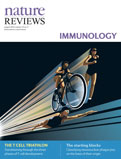|
| TABLE OF CONTENTS | |||||||||||||||||||||||||||||||||||||||||
| August 2014 Volume 14 Number 8 | |||||||||||||||||||||||||||||||||||||||||
| In this issue
| ||||||||||||||||||||||||||||||||||||||||
| |||||||||||||||||||||||||||||||||||||||||
 | |||||||||||||||||||||||||||||||||||||||||
| Advertisement | |||||||||||||||||||||||||||||||||||||||||
| |||||||||||||||||||||||||||||||||||||||||
| |||||||||||||||||||||||||||||||||||||||||
| PROGRESS | Top | ||||||||||||||||||||||||||||||||||||||||
| OAS proteins and cGAS: unifying concepts in sensing and responding to cytosolic nucleic acids Veit Hornung, Rune Hartmann, Andrea Ablasser & Karl-Peter Hopfner p521 | doi:10.1038/nri3719 The presence of nucleic acids in the cytosol alerts the cell to viral infection or damaged self. The oligoadenylate synthase (OAS) proteins and cyclic GMP–AMP synthase (cGAS) are enzymes that detect this danger and promote antiviral immunity. Recent structural studies reveal that these enzymes have a common mechanism of action and probably the same evolutionary origin. Abstract | Full Text | PDF | |||||||||||||||||||||||||||||||||||||||||
| REVIEWS | Top | ||||||||||||||||||||||||||||||||||||||||
| Developmental gene networks: a triathlon on the course to T cell identity Mary A. Yui & Ellen V. Rothenberg p529 | doi:10.1038/nri3702 T cell development can be divided into three major regulatory phases by the checkpoints that occur at commitment to the T cell lineage and at β-selection. The three phases are each governed by different gene networks that confer distinct cellular characteristics. The correct developmental programme depends on the sequential operation of these gene networks, and cells that fail to enforce the boundaries between phases may be predisposed to leukaemic transformation. Abstract | Full Text | PDF | Supplementary information | |||||||||||||||||||||||||||||||||||||||||
| Assembly and localization of Toll-like receptor signalling complexes Nicholas J. Gay, Martyn F. Symmons, Monique Gangloff & Clare E. Bryant p546 | doi:10.1038/nri3713 In this Review, the authors describe how Toll-like receptors (TLRs) assemble with signalling adaptor proteins to form higher-order scaffolds that signal in response to pathogen sensing. Productive TLR signalling involves cooperative assembly, post-translational modification and subcellular localization of the components of the signalling complexes. Abstract | Full Text | PDF | Supplementary information | |||||||||||||||||||||||||||||||||||||||||
| Immune modulation by butyrophilins Heather A. Arnett & Joanne L. Viney p559 | doi:10.1038/nri3715 The butyrophilins are members of the immunoglobulin superfamily that have previously been poorly understood, however they are now emerging as key modulators of the immune system. Here, the authors describe the diverse ways in which butyrophilins can modify immune cell activity and discuss the potential of targeting this family for therapeutic purposes. Abstract | Full Text | PDF | |||||||||||||||||||||||||||||||||||||||||
| PERSPECTIVES | Top | ||||||||||||||||||||||||||||||||||||||||
| OPINION Dendritic cells, monocytes and macrophages: a unified nomenclature based on ontogeny Martin Guilliams, Florent Ginhoux, Claudia Jakubzick, Shalin H. Naik, Nobuyuki Onai, Barbara U. Schraml, Elodie Segura, Roxane Tussiwand & Simon Yona p571 | doi:10.1038/nri3712 Cells of the mononuclear phagocyte system (MPS) are usually defined by particular functional or phenotypical characteristics. However, this has led to confusion in the field, as many of the criteria that are used to define a particular cell population may actually be shared with other cell types. In this Opinion article, the authors propose that a new nomenclature that is based on cell ontogeny could enable a more robust classification of MPS cells. Abstract | Full Text | PDF | Supplementary information | |||||||||||||||||||||||||||||||||||||||||
| Corrigendum: Consortium biology in immunology: the perspective from the Immunological Genome Project Christophe Benoist, Lewis Lanier, Miriam Merad, Diane Mathis & The Immunological Genome Project p578 | doi:10.1038/nri3714 Full Text | PDF | |||||||||||||||||||||||||||||||||||||||||
| Advertisement | |||||||||||||||||||||||||||||||||||||||||
| |||||||||||||||||||||||||||||||||||||||||
| |||||||||||||||||||||||||||||||||||||||||
| *2012 Journal Citation Report (Thomson Reuters, 2013) |
You have been sent this Table of Contents Alert because you have opted in to receive it. You can change or discontinue your e-mail alerts at any time, by modifying your preferences on your nature.com account at: www.nature.com/myaccount For further technical assistance, please contact our registration department For print subscription enquiries, please contact our subscription department For other enquiries, please contact our feedback department Nature Publishing Group | 75 Varick Street, 9th Floor | New York | NY 10013-1917 | USA Nature Publishing Group's worldwide offices: Macmillan Publishers Limited is a company incorporated in England and Wales under company number 785998 and whose registered office is located at Brunel Road, Houndmills, Basingstoke, Hampshire RG21 6XS. © 2014 Nature Publishing Group, a division of Macmillan Publishers Limited. All Rights Reserved. |
 |









No comments:
Post a Comment